My SciELO
Services on Demand
Article
Indicators
Share
Brazilian Political Science Review (Online)
On-line version ISSN 1981-3821
Braz. political sci. rev. (Online) vol.3 no.se Rio de Janeiro 2008
Brazilian democracy and the power of "old" theories of party competition*
Fabiano Santos
IUPERJ, Brazil
Replicated from Brazilian Political Science Review (Online), Rio de Janeiro, v.2, n.1, Jan/Jun. 2008.
ABSTRACT
Brazilian politics has been usually analyzed as a case full of pathologies by scholars and political journalists alike. Fragmentation, volatility, clientelism and inefficiency have become bywords for describing the performance of Brazil's political institutions. As a counter to this view, this work argues that the country's democracy in the post-1988 period presents enough evidence in favor of classical hypotheses about electoral politics in the contemporary world, theories that invariably are based on premises of rationality in the behavior of voters and political parties. These theories include the median voter theorem, Duverger's law on the mechanical and psychological effects of electoral systems, and the model of retrospective voting. The article also contends that the passing of time has contributed to make Brazilian politics more rational and efficient in the mould of older democracies.
Keywords: Brazilian democracy; Theories of party competition; Democratic stabilization.
Introduction
The main aim of this essay is to provide a reflection about the recent political process in Brazil and in so doing to contribute to greater understanding of the hurdles to democracy in South America as a whole.1 Until recently, the Brazilian political system was held as a flawed example not to be followed — a presidential system with open-list proportional representation, "robust" federalism and strong bicameralism, several analysts said, had everything to go wrong.2
Indicators of the mistake were displayed in abundance — high party fragmentation, permanent instability, electoral volatility, charges of corruption, clientelism and self-perpetuating elites. And yet something began to change in the 1994 election, with the victory of Fernando Henrique Cardoso, running for president with the support of a centre-right coalition formed by his own party, the PSDB3, and the main rightist party of the country, the PFL Since then, the party system has gained in clarity, organised around four strong parties — PSDB, PFL, PMDB and PT — and three or four medium-sized ones — PP, PDT, PTB and PL.
Furthermore, a string of analyses started showing that governing processes are not in the least chaotic, since consistent coalitions, ideologically connected, render some predictability to the political system's operation. The administrations and party leaders were quite successful in handling the legislative agenda through National Congress channels (Figueiredo and Limongi 1999). These findings give rise to an interesting debate about the conditions for governance in the so-called coalition-based presidential system.4
As the new century starts, the great test of every democracy takes place — power changes hands with the rise to the presidency of Cardoso's main opponent during the previous eight years. Luiz Inácio Lula da Silva, originally a factory worker and union leader, the dominant figure of the PT, the largest leftist party, is elected in 2002, governs, and is re-elected in 2006. A concomitant phenomenon is the continuing dominance in the legislative arena of the same four parties, which reveals a surprising stability of the party system in view of pessimistic diagnoses prevailing in the mid-1990s. If this picture is looked at in broader historical perspective, it would not be impertinent to speak of stabilisation and consolidation of democracy. What, then, is the mistake of the pessimistic analyses?
I argue that analytical gains would be greater should the lessons of certain "old" theories about democracy be taken into account. Such theories have in common a basic factor — time —, and its absence in traditional views is clearly damaging to their explanatory power. The underestimation of political actors' capacity to adapt to institutional rules, as well as their potential for strategic coordination within a set of given institutions, is a recipe for error and bad predictions. We shall see that the three theories informing my analysis presuppose that political phenomena unfold over time. In short, flawed assessments lie in wait for those who disregard time-effects in Brazilian politics.
The paper is organised as follows. In the next section, I present two theses that I deem mistaken about Brazilian politics in the last fifteen years. I use the theory of the median voter to counter the two views, calling attention principally to the centripetal nature of party competition, particularly for majority elections such as the presidential election. In the third section, I analyse the evolution and format of the party system by bringing up key lessons of the theory of electoral systems' political consequences. As political elites accommodate their strategies to party competition, having in mind the distribution of electoral preferences and the electoral rules, further stability and clarity are given to the party scenario in the country. In the fourth section, I examine the rationality of voters' behaviour in Brazil. I show that voting decisions in the last presidential races might be understood as an empirical example of the theory of retrospective voting, which is to say that the political behaviour of Brazilian voters is perfectly compatible with what sound political science is used to defining as rational behaviour. In the concluding section, I discuss how my analysis can be used to understand the political landscape in South America.
Two Erroneous Arguments and the Theorem of the Median Voter5
Two arguments, both false in my view, have shaped political debate in Brazil in varying degrees. The first states that the two most successful parties in the presidential races are in fact twins in disguise; that is, they do not display any essentially substantial differences in terms of agenda priorities and public policies. This phenomenon would ultimately compromise democratic performance, for it would deprive voters of their ability to choose distinct proposals on how to handle the nation. The second argument, logically derived from the first, contends that there would be room in the Brazilian political landscape for a third way, an authentic leftist alternative capable of leading the country towards a break with the status quo by combining growth with social justice.
The two views will be criticised with the same argument: the evolution of party competition as to the presidential race becomes intelligible once it is interpreted as an empirical example of Anthony Downs's (Downs 1957) median voter theory (MVT). Its key proposition is as follows:6 in majority elections, the winning candidate is the one who, once hegemonic in one of the extremes of the political spectrum, conquers the support of the voter positioned in the centre of the same spectrum.
Table 1 displays results of presidential elections since 1989, considering only the votes obtained by the three most successful candidates in the first round.
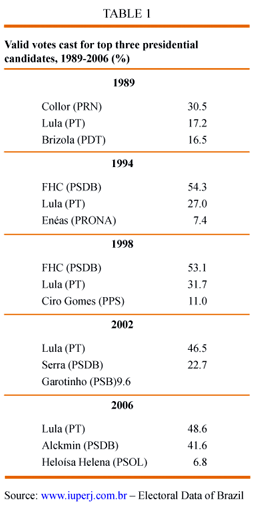
One can see an emerging picture of stability, which can also be extended to the case of legislative elections, especially for the Chamber of Deputies. Since 1989, the year of the first presidential election after 29 years, the PT has been the main competitor from the leftist side of the political spectrum. Among the centre-right electorate, from 1994 on, the PSDB, in alliance with the PFL in 1994 and 1998, has been the preferred option. It is noteworthy that the PMDB, the most structured party, strong in Congress and state governments, forsook running candidates for president in 1998 and 2002 after winning only 4.7% of the vote with Ulysses Guimarães in 1989 and 4.4% of the vote with Orestes Quércia in 1994. The argument upheld in this section is that such results are brought about by a centripetal logic that has defined Brazilian politics since the re-democratisation.
Two important objections are frequently brought up about the use terms such as "left" and "centre-right". The first questions the pertinence of applying the latter label to the alliance between PSDB and PFL, while the second casts doubt on whether the PT in government is any different from Cardoso's eight-year presidency. The answer to these challenges is relatively straightforward and is in fact one of the reasons why Brazil's political process has increasingly become akin to those of its counterparts in the so-called "mature democracies".
After all, the reason why PT and PSDB are the most successful parties in presidential races is a consequence of a basic law of electoral politics in majority elections: the winning candidate will be the one who is more trusted by the centre voter.7 However complex political life in modern societies may seem, there is essentially a single fundamental cleavage of political forces in a capitalist country: the actors who organise around the world of labour versus the actors who organise around the world of capital. The replication of this cleavage in the world of ideas is expressed by the famous right-left ideological continuum along which parties, leaders, voters, interest groups and opinion-makers position themselves. The matter here is not whether the PSDB is a centre, centre-right or centre-left party, but rather, that it actually became with the pro-market reforms of the last decade the most competitive and trustworthy option for conservative voters. Conversely, and less controversially, it is a fact that PT is the most competitive and trustworthy option for leftist voters.
Quite simply, recent features of Brazilian politics strongly suggest that PT and PSDB, while gathering votes from leftist and rightist quarters respectively, are the parties best placed to attract the centre voter, decisive in a majority election. The causes of this situation would require a lengthy discussion outside the scope of this article. Nonetheless, in the case of PT, one could point to its origin in unions and social movements, the fact it never adopted an official ideology, rigorous internal rules and sophisticated methods of organisation and mobilisation. As for the PSDB, the elements to be highlighted to explain its success include the recruitment of experts with high levels of expertise and a strong base of support in São Paulo state.
One pointed criticism to this state of affairs is that the two parties are too similar, depriving the electorate of the ability to differentiate between them and identify alternative agendas and policy changes in the government. It is at this point that the median voter theory is sorely needed. The similarity between the top contenders for Brazil's presidency does not originate from any "common essence" of PT and PSDB, and even less from the will, interests and ideas held by their leaders. Very much in line with proceedings in "developed" democracies, such similarities are determined by the very nature of electoral competition, which puts a premium on the satisfaction of centrist voters' dearest issues.
It is worth recalling that the most important demands of the Brazilian median voter are contradictory to some extent. Monetary stability is desired alongside with a penchant for economic growth and more jobs. Social spending is sought while struggles for raising incomes and reducing taxes occur at the same time. Therefore, in a sense it is understandable that successive administrations promote policies that are similar up to a point. Nevertheless, a detailed analysis of what has happened in Brazil during the Lula and Cardoso administrations clearly shows the limits of the similarities mentioned above.
In fact, there are arguable differences that widely separate parties such as PT, PSB and PCdoB from their opponents PSDB and PFL on the question of the means to enhance economic development. While the former set of parties seeks a more active public sector, the latter is fond of privatisations in tandem with cuts both in the state machine and labour rights. While the first group favours a foreign policy oriented towards regional integration and markets in developing countries, the second group disagrees, emphasising historical relations of cooperation with developed countries, especially the United States. Not to mention the radical expansion of social policies based on income transference to poor people brought about by the current administration, which is criticised as clientelistic by many members of the opposition. The effects on electoral behaviour of these policies will be dealt with in the fourth section.
For the reasons discussed above, the assertion that negates the differences between PT and PSDB has no plausible support, although it is true that the economic policy, identical under Lula in its fundamentals to what Cardoso practiced, may limit significantly what the government can and cannot do in terms of growth and social promotion. And this gap between former expectations and actual achievements generates the groundless impression that the two presidents and their parties are twins in disguise.
The second thesis to be examined is closely related to the first: since PT and PSDB are so similar, a "third way" would be necessary to promote a bold agenda of economic growth and social inclusion, a political force free of the ideological inclinations and vested interests behind both parties. The thesis is as fragile as it is dangerous and will be refuted according to the logic of median voter theory. I shall begin by pointing out its weaknesses in order to discuss in greater detail the risks posed by the belief in a "third way" later on.
As posited by the MVT, in a majority election in which the candidate is elected with 50% +1 of the votes, the winner is the one who obtains the support of one of the political spectrum's extremities and, additionally, wins over the voter placed in the centre. Thus the victorious competitor succeeds in gaining the median voter after having consolidated their base of support either on the left or the right, as the case may be. Three important consequences can be derived from this assumption:
1) The most competitive parties will clearly be the ones that have historic and close-knit ties with interest groups, the intelligentsia and social movements connected either with the right or the left. Higher chances of success are enjoyed by those who, while keeping their traditional sources of support, signal credibly to the centre voter. Note that, however unhappy extremity voters may become with the moderation in the speeches and actions of their natural candidates, they have no other alternative than to vote for the latter, lest the opponent in the other extremity win.
2) Parties placed in the centre of the spectrum have fewer chances of victory. In order to win, they are obliged to appeal to voters present in one of the extremities. In so doing, however, they naturally radicalise their messages, creating intra-party tensions and alienating their traditional supporters in the centre. This situation creates the image of a "squeezed candidate",8 between two strong contenders coming from the extremities. They effectively moderate their messages and grab votes from the centre candidate's original electorate. After all, the latter is attracted by the competitiveness of its new choice, which may curtail the odds of the most feared candidate.
3) Parties generated in one of the extremes that insist on radical campaigns stand to lose indefinitely in majority elections. This is so because the only way to increase their pool of votes is to moderate their platforms and become palatable to centre voters.
These propositions of MVT largely explain what has happened in Brazilian politics since the democratic transition, especially about presidential elections, and should be a useful guide for describing electoral scenarios for future presidential campaigns.
The first proposition is easily verifiable. It is enough to recall that in the last four presidential elections the strongest candidatures have come from the PT, which musters leftist forces and reaches out to middle-class support along with votes of less ideologically-inclined voters, and the PSDB, which gathers conservative voters through the alliance with the PFL and obtains support in the centre by using its own image of moderation. In support of the argument, it is worth adding that the defeat of the PSDB in 2002 occurred after a split with PFL and a successful match between PT and the centre-right PL that helped the former to increase the credibility in its moderate stance.
As for the second proposition, its implications can be better understood from the successive failures of PMDB in its bids for the presidency. Some political pundits attribute the abandonment of Ulysses Guimarães in 1989 and Orestes Quércia in 1994 to treachery and personal power games inside the party. However, the truth of the matter is that such candidacies were born and stagnated in the political centre, ultimately being squeezed by strong contenders coming from the extremes. By abandoning the party candidates, certain PMDB factions were in fact making a strategic move in search of a better accommodation in a not so promising post-election future.
Evidence in favour of the third proposition is so overwhelming that one need not waste much time in presenting it. I cannot recall any extreme candidates who may have been successful in the elections and I see no reason, either conceptual or empirical (from opinion polls, for instance), that could indicate the contrary.
In addition to mentioning the weakness of the third way thesis, I also pointed out that risks accompany it. Suppose that a given "exogenous shock" damages considerably the electoral performance of the strongest parties so far in presidential elections. Suppose further that new candidates, from the centre and extremes of the political spectrum, emerge to take advantage of the political void caused by the exogenous shock. These actors would present themselves as the "real alternatives" for voters, capable of redesigning public policies, alter priorities and, in a nutshell, reinvent Brazil as to economic growth and social inclusion. Suppose, lastly, that one of these competitors wins the presidential race. What would be the main implication of such a scenario?
In matters of politics, few things are impossible, but there is always an underlying logic. If elected, a third way candidate would face the same problems, constraints and contradictory societal demands. Voters demand monetary stability, growth and jobs at the same time. They wish for tax cuts along with social spending and better public services. Public creditors will be the same and their interests are not likely to change simply because someone is elected naming themselves as the alternative to everyone else. Campaign times do not correspond to realities of government. Once in power, an administration should squarely face pressures and the interests of those who have real bargaining power.9 In short, the most likely scenario of an emerging and victorious third way is the maintenance of orthodox policies such as macroeconomic fiscal responsibility and tight inflationary control so as to ensure government survival.
The dangers of a third way lie precisely in its inconsistency as a political project. Should its candidate lose, its messages will have been only healthy elements in the political debate, to be taken into account in the definition of the country's agenda and in tackling its problems. Should its candidate win, however, his or her government will probably follow the same strategies followed by previous presidents, producing increasing feelings of frustration in the electorate as regards party and democratic institutions generally.
Institutionalisation of the Party System and the Political Consequences of Electoral Laws
It is quite common to hear analysts evaluate political parties negatively in Brazil. Two basic charges are made against the country's party system: 1) parties are essentially weak in the electoral arena; and 2) the party system itself is poorly institutionalised. I shall deal with this assessment by using another "old" theory about how political competition really works in democratic settings. If, in the former section, we saw that the median voter theory explains perfectly certain apparent anomalies in the Brazilian political system, we now turn our attention to the theory that describes observed outcomes in the party system as systematic effects, mechanical and psychological in nature, of the use of the electoral legislation over time.
Maurice Duverger (1958) is the author responsible for the first version of this theory, according to which majority electoral systems tend to bring about two-party systems, while proportional electoral systems tend to generate multiparty systems. Later, Douglas Rae (1967) proposed a slightly distinct version, which in fact augmented the theory's explanatory powers. Basically, the model developed by Duverger and Rae may be summarised as follows: the party system of a democratic country, understood as the set of parties that make up a given system of competition for votes, as well as the distribution of their strength in representative bodies and government offices, is the outcome, in the first place, of voters' preferences, and, in the second place, of electoral law: majority systems tend to reduce the number of relevant parties and proportional systems allow a fairer expression of the dispersion of preferences present in the electorate.
Let us examine what has happened to party competition in Brazil since re-democratisation. Since the 1990 election, about 19 parties have elected representatives to the Chamber of Deputies. In ideological terms, these parties can be classified in the fashion below:
Left: PT, PDT, PSB, PCdoB, PPS, PV, PMN.
Centre: PMDB and PSDB.
Right: PFL, PP, PTB, PL, PRONA, PST, PSD, PSDC, PSC, PSL.
Many of these parties are tiny, to be sure, but party fragmentation is very high, 0.88, as Table 2 shows. This finding has led analysts to conclude that the system displays low levels of institutionalisation.
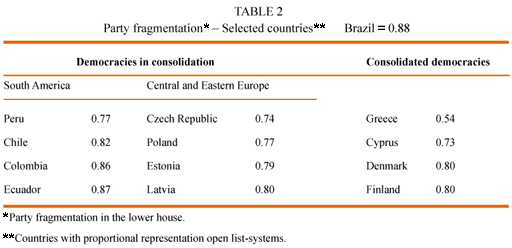
Despite the high level of fragmentation, the Brazilian party system is quite stable, in my view. In fact, the system has been characterised by the dominance of 5 "strong" parties: PT, PMDB, PSDB, PFL and PP. Consider, for instance, as strong parties those that control at least 10% of the seats in the Chamber and elect federal deputies in more than 2/3 of the states (Tafner 1997). In 1994 and 2006, these parties got on average no less than 73% of the votes in the election for the Chamber.
The last three legislative elections have borne the mark of the party system's stability. After all, the last great electoral realignment took place in the 1990 election, when PMDB lost more than half of the votes received in the previous election (a reduction from 48% to 19%). Both the rise of PSDB (1994 and 1998) and of PT (2002) to the presidency were associated with gains in proportional elections, but they were altogether modest — around five percentage points. If we use a simple index to measure stability, such as the electoral volatility indicator,10 one can see that the average number in the past three elections equalled 0.15, as Graph 1 shows.
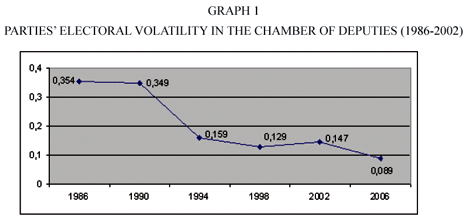
With the aim of providing comparative evidence on volatility indexes and how the Brazilian index of about 0.15 should be assessed, I present Table 3. Among countries that use similar electoral systems, only the Chilean party system in Latin America has exhibited higher levels of stability. In Eastern and Central Europe, no country has smaller indexes, and Denmark and Switzerland, grouped here in the "consolidated democracies", are not that far off. These numbers should not be underrated: one of the main indicators used by analysts to identify the Brazilian case as one of "party underdevelopment" is exactly electoral volatility, as if excessive fragmentation revealed a landscape of party confusion instead of simply denoting political pluralism in an immense country that has undergone rapid and important transformations in politics, the economy and society.
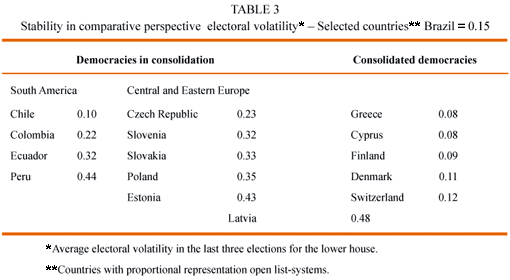
Furthermore, and in spite of the stability, an interesting political phenomenon has taken place in Brazil, namely a tendency to the polarisation of the party system. The electoral force in the "centre" is diminishing by virtue of: 1) persistent electoral losses of PMDB, somehow softened by the 2006 election results; and 2) the movement of PSDB to the right. The parties most favoured by "centrist" losses are the leftist ones, especially the PT, which added five percentage points to its electoral performance. Its electoral gain corresponded to about 40% of the electoral losses in Cardoso's coalition. On the right, only the PFL (now called DEM) augmented its caucus in the Chamber during president Cardoso's two terms. The total vote of the remaining rightist parties has decreased gradually, especially in the case of the PP.
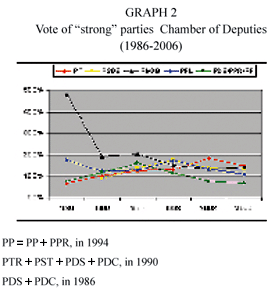
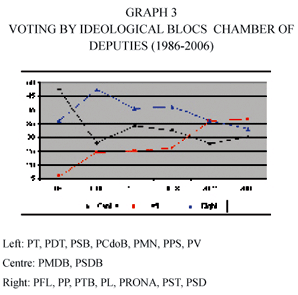
What do the stability and the slight polarisation suggest in terms of long-term tendencies? As time goes by, party labels have laid roots in Brazilians' political opinion. The party structure has become clearer, with the options offered to the electorate defining more precisely their position in the ideological spectrum and their main allies, as well as their chief foes. Key opinion polls have revealed that no less than 40% of voters expressed sympathy for or identified with some party — a figure above the world average and that of some so-called "exemplary" or "mature"11 democracies. Moreover, the Brazilian voter has responded rationally to the movements of political elites, by voting sincerely in proportional elections and strategically in majority elections. Table 4 and Graph 4 illustrate well how preferences and electoral rules, very much in line with the predictions of the Duverger/Rae model, have shaped the party system.

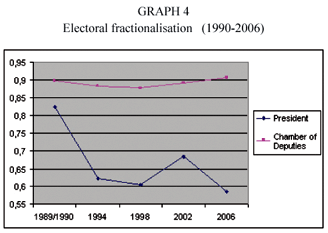
Naturally, the competition for the executive is less fragmented than its legislative counterpart. But this distance has significantly increased since the first presidential election by popular vote after the 1964 military coup. In 1989, when Fernando Collor won, party fragmentation was identical to that found in the following year for the Chamber of Deputies. As elections go by and leave their marks, competitive blocs for majority races become well defined and the fragmentation, owing to mechanical and psychological effects of this electoral formula, become quite reduced. From 1994 on, the fragmentation is a function of greater (2002) or smaller (1998 and 2006) competitiveness of the election itself.
The Theory of Retrospective Voting and Voter Rationality
All too often we also read analyses that view Brazilians' electoral behaviour negatively. The problem now corresponds to the classic issue of a citizenry unprepared for the exercise of democracy. Fundamentally, there are two charges usually made against voters: 1) voters are uninformed about basic facts of political life; and 2) they tend to trade-off votes for pecuniary compensations or particularistic goods. These phenomena explain why practices such as clientelism and populism, as direct consequences of ignorance and economic dependence, are so routinely found in the Brazilian setting. The rebuttal of such theses will make use of another "old" theory on how political competition works in democratic regimes. To sum up, electoral behaviour in Brazil can be explained in accordance with a respectable theory about electoral decision-making much used to understand political decisions in developed countries.
The theory, according to which voters in a democracy vote retrospectively by observing present outcomes of past actions associated to decisions of the incumbent administration, was initially formulated by V. O. Key Jr. (1966). In a classical work about American national elections, Morris Fiorina (1982) included Key's reasoning in the perspective of voter rationality. His basic assertion can be summarised as follows: voting decisions are the result of an ongoing evaluation made by voters about promises and achievements of candidates and parties, giving rise ultimately to something that may be defined as party identification, which is based on this set of past experiences either when ascribing responsibility to current social conditions or assessing platforms to deal with uncertain scenarios.
I shall gather proof that this theory renders the electoral process in Brazil intelligible on three counts. Firstly, I deal with the relation between party identification and voting intentions in the last two presidential races, examining how the former induces the formation of the latter. Secondly, I use opinion polls to show the linkage between issues and voting, a key element of the prospective dimension of the theory. Lastly, I develop an assessment of the results of the 2006 presidential election, in which Lula was re-elected, seeking to relate them to public policies implemented by the administration — the retrospective side of the theory is emphasised here.
Tables 5 and 6 denote the relation between party identification and voting intentions of the winner in the 2002 and 2006 elections. Such results are quite strong both in the spontaneous and in the stimulated frame choices put to the interviewees. In the first set, 82% and 84% of people who sympathised with PT in 2002 and 2006, respectively, said they would vote for Lula. In the second set, the figures reached 91% on both occasions, in other words, a striking stability. These items of information should not, however, be read only under the perspective of the support given to Lula by sympathisers of his own party. The same analysis holds for the aggregate behaviour of the electorate. Voters who were least inclined to vote for Lula have showed some sympathy for the main opponents of PT since 1994, PSDB and PFL (nowadays called Democrats).
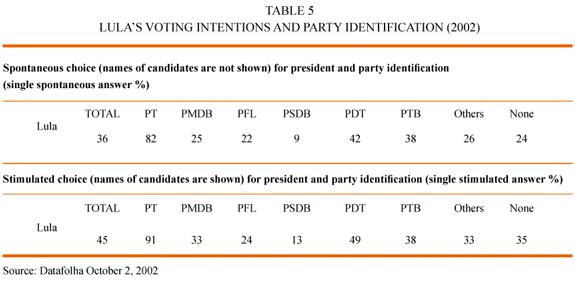
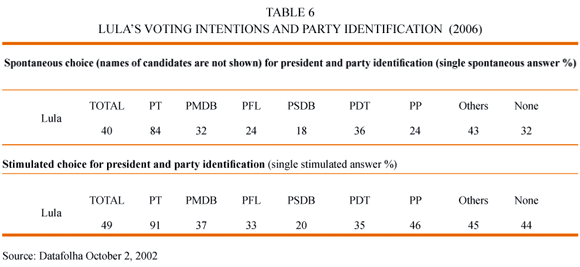
So far, nothing really surprising has been seen with regard to electoral behaviour. Only the simple fact, doubted by the most pessimistic analyses of Brazilian politics, that party identification (PI) is a relevant variable to explain voting decisions. But what is PI? According to the theory of retrospective voting, PI is not brought about by some sort of sociological internalisation of values initiated in infancy and defined by the ecology in which the individual is socialised. The best definition of PI presupposes the importance of the political information absorbed by individuals as they grow up, and that is why family life and social environment are important. Nonetheless, it also includes essentially one's own personal evaluation about the evolution of one's welfare, opinions about fundamental events of political life and the association between these and politicians' decisions. In other words, PI is an amalgam of past political experience, although exposed to permanent re-evaluation.
In the Brazilian context, it would be unwarranted to say that political parties organise the civic awareness of the environment where individuals are socialised. Nevertheless, the rates of party sympathy reach the 40% mark, above the international average (Klein 2007). It is on this apparent paradox, a significant response in favour of parties in tandem with societal restrictions to parties as a means of political socialisation, that the importance of retrospective voting theory squarely rests. It is widely known, on the other hand, that a party like PT was created and organised partly by unions. Therefore, in elections where the issue "work" is salient, there is nothing more natural than to perceive an added strength for this party's candidates. In Tables 7 and 8, one may observe the issues of most concern to voters and their evaluation of how the two top candidates of 2002, Lula (PT) from the opposition and Serra (PSDB) from the administration, would deal with these problems.
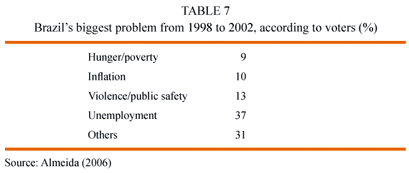
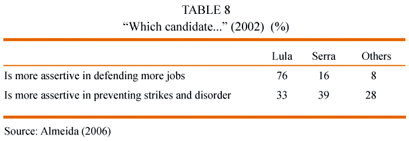
What can be inferred from these data? Quite clearly, voters identified unemployment as the key issue in the public agenda to be dealt with by the government. Note that inflation had not become an irrelevant problem, which explains Lula's caution in handling his stance on economic stability in the 2002 campaign — an attempt to attract the median voter. Violence and poverty were the other items most cited. The second table reveals the reason for Lula's large advantage over his adversary: no less than 77% of those interviewed said that the PT candidate had better proposals for employment, versus 16% who said the same of Serra. Conversely, as for social order and public safety, the advantage is clearly on the PSDB candidate's side.
At any rate, what the tables show is a basically prospective scenario — two candidates promising policies for a future term, with neither one being able to use performance on the job as a demonstration of his ability to deal with the central problems afflicting the voter. How does the latter react to the proposals? Consistent with the postulate of the retrospective voter theory, campaign information was filtered by experience accumulated in the past. With employment as the main issue, nothing would be more natural than to imagine the candidate of a party linked to the world of work as the one better suited to deal with the issue. Conversely and symmetrically, the voter's negative evaluation of the incumbent administration's performance in this area was transferred to the candidate representing it. That is, even in moments when there is no solid memory on the basis of which political information can be interpreted, the voter relies on clues like PI and the government-versus-opposition dichotomy as recourses for calculating his/her voting decision.
In the 2006 elections, Lula was re-elected with a very similar margin to that of 2002, but a striking difference emerged in the social and demographic distribution of the votes. In his first election, the votes were distributed evenly among the population, regardless of the size of the municipality, percentage of urban population, poverty and illiteracy rates etc, but the same was not true in 2006. Table 9 shows the correlation between votes for Lula in a given municipality and various social and demographic indicators.

Interpretation of the table leaves no room for doubt: while in 2002 the correlations were all negative, in 2006 they all became positive, and were quite high for poverty, percentage of the population with no schooling, the infant mortality rate and coverage of the Bolsa Família program (the latter showing the highest correlation). In other words, the poorest municipalities tended to concentrate voters for Lula, and more specifically those who most benefited from the government's main anti-poverty program. Note that it was precisely in these municipalities that income, employment and per capita Gross Domestic Product (GDP) increased the most during the current administration's first term. The response by the President's voters in support of his re-election is a direct consequence of the way Brazilian voters conduct their political calculations, based on past experience, deriving from the results of policies and the associations between them and the performance by politicians heading the administrations. In other words, voters' response was exactly as predicted by the rationality of political behaviour based on the retrospective voter theory.
Conclusion
In the previous sections I have attempted to show that since the re-democratisation that began in 1985, the Brazilian political system has displayed characteristics that are compatible with what is expected from the nature of functioning, stable democratic regimes. Contrary to the pessimist views on the political process in Brazil, fed by hasty hypotheses on the relationship between institutions and political results, over time we have witnessed the emergence of a mass democracy with no visible signs (either apparent or distant) of threats to democratic institutionality. I have used three "old" theories on the functioning of democracy to identify the reasons why the pessimistic views have failed.
The elites organise in parties and compete for the voters positioned in the centre of the political spectrum, as posited by the theory of the median voter, formulated by Anthony Downs. The importance of this observation lies in the centripetal nature of electoral competition with the resulting desideratum of moderation. We have also observed among the elites, but specifically in their party strategies, that the political consequences of electoral legislation, as proposed by Maurice Duverger and Douglas Rae, are perfectly compatible with the Brazilian party system's evolution and current format. Elections governed by majority rule tend to draw a relatively small number of contestants, unlike those governed by the proportional vote, characterised by fragmentation of the party scenario. Still, one also notes an important stability in the support given to these same forces. In short, with regard to voters, inspired by the retrospective voter theory, I have shown that the electorate has based its voting decisions on the classical canons of rationality and consistency. Information is processed in the light of past experiences and the results of policies associated with the performance of the main political players heading the government. Party identities are phenomena that are processed over time, as voters experience democracy.
In fact, time is the main factor missing from the pessimistic views. The political analyst should always bear in mind that politics is a historical phenomenon, and the effects of institutions on the players' strategies are thus also historical phenomena. The players accommodate their strategies on the basis of the learning they acquire on the behaviour of their peers and opponents, and the formal and informal rules governing the struggle for power. Without the dynamic element inherent to any political process, it is very difficult to formulate adequate explanations concerning the possibilities for stabilisation of the political game. Indeed, all three theories used in this study to interpret the recent history of Brazilian politics have time as a crucial variable.
But from the point of view of the lessons we can extract from this analysis for the more general case of democracy in Latin America, what can one say? Returning to the beginning of the article, what appears to be the most important variable in the stabilisation and rationalisation of the political game in Brazil is the emergence of a strong leftist party, both at the ballot box and in Congress, whose leaders are focused on occupying government with the aim of promoting changes to the status quo, within the context of the rules of representative democracy. This characteristic helps generate desirable results in terms of the interaction between the elites and society — the possibility of actual alternation in power; moderation in political strategies and rhetoric; a culture of negotiation and coexistence between government and opposition. It is difficult to tell to what extent this system can survive in spite of the economic fragility of the Latin American countries, their delicate social situation, so heavily marked by poverty and inequality, and a socioeconomic elite that is still largely hostage to prejudices and an oligarchic civic culture. What we do know, however, is that without the development of a competitive and pragmatic political party, identified with the interests of the excluded segments, it is virtually impossible for us to conceive of a representative democracy worthy of the name and thus with good possibilities for institutionalisation.
Glossary
DEM – Democratas
PCdoB – Partido Comunista do Brasil
PDC – Partido Democrata Cristão
PDT – Partido Democrático Trabalhista
PFL – Partido da Frente Liberal
PL - Partido Liberal
PMDB – Partido do Movimento Democrático Brasileiro
PMN – Partido da Mobilização Nacional
PP – Partido Progressista
PPS – Partido Popular Socialista
PPR – Partido Progressista Republicano
PRN – Partido da Reconstrução Nacional
PRONA – Partido de Reedificação da Ordem Nacional
PSB – Partido Socialista Brasileiro
PSC – Partido Social Cristão
PSD – Partido Social Democrático
PSDB – Partido da Social Democracia Brasileira
PSDC – Partido Social Democrático Cristão
PSL – Partido Social Liberal
PSOL – Partido Socialismo e Liberdade
PST – Partido Social Trabalhista
PT – Partidos dos Trabalhadores
PTB – Partido Trabalhista Brasileiro
PTR – Partido Trabalhista Renovador
PV – Partido Verde
Notes
1 I say South America as a whole because almost all the countries in the sub-continent have their political system based on the presidential system of government and proportional regimes of representation. As will become clear, various analysts are still quite pessimistic about this kind of institutional combination.
2 Good examples of this line of research are Ames (2001), Geddes (1994), Mainwaring (1997, 1999), and Samuels (2003).
3 A glossary with the parties' names in full can be found at the end of the article.
4 For a survey of the debate, see Santos and Vilarouca (2006).
5 Section 2 and 3 are a modified version of Santos (2003)
6 The following formulation is not a quotation, but rather my own version of the respective theory. The same is valid for the formulation of the two other theories mentioned in the article.
7 Countless works in modern political science refer to or make use of the median voter theory in order to analyse elections, congressional roll-calls, coalition-making and party make-up of cabinets. Classical texts are Black (1958) and Downs (1957). More recently, Cox (1990) published an excellent analysis that applies the theory to several institutional contexts.
8 Again Cox (1990) is the best reference for an analysis of the "squeezed" centre alternative.
9 I do not mean that governments should be controlled by organised groups, but rather that interaction with key agents in the social and economic structure is an important step towards the stability and efficiency of the governmental agenda.
10 The volatility index assumes values ranging from 0 to 1. Hypothetically, 0 represents a situation in which each party repeats the vote of the previous election, while 1 represents a situation in which every vote is given to parties that did not run in the previous race.
11 This is information was collected from Klein (2007)
Bibliographical References
Ames, Barry. 2001. The deadlock of democracy in Brazil. Ann Arbor: University of Michigan Press.
Almeida, Alberto Carlos. 2006. Por que Lula? O contexto e as estratégias políticas que explicam a eleição e a crise. Rio de Janeiro: Editora Record.
Black, Duncan. 1958. The theory of committees and elections. New York: Cambridge University Press.
Cox, Gary W. 1990. Centripetal and centrifugal incentives in electoral systems. American Journal of Political Science 34:903-35.
Downs, Anthony. 1957. An economic theory of democracy. New York: Harper Collins.
Duverger, Maurice. 1958. Les partis politiques. Paris: Armand Colin.
Figueiredo, A., and F. Limongi. 1999. Executivo e Legislativo na nova ordem constitucional. Rio de Janeiro: Editora da FGV/Fapesp.
Fiorina, P. Morris. 1982. Retrospective voting in American national elections. New Haven: Yale University Press.
Geddes, Barbara. 1994. Politician's dilemma: Building State capacity in Latin America. Berkeley: University of California Press.
Key, Jr. V. O. 1966. The responsible electorate. New York: Vintage.
Klein, Christian. 2007. O desafio da reforma política: Conseqüências dos sistemas eleitorais de listas aberta e fechada. Porto Alegre: Mauad.
Mainwaring, Scott. 1997. Multipartism, robust federalism, and presidentialism in Brazil. In Presidentialism and democracy in Latin America, ed. Scott Mainwaring and Matthew Shugart, 55-109. Cambridge: Cambridge University Press.
______. 1999. Rethinking party systems in the third wave of democratization: The case of Brazil. Stanford: Stanford University Press.
Nicolau, Jairo, and Vitor Peixoto. 2007. Bases municipais da votação em Lula em 2006. Position Paper 2, Fórum Especial Internet, Fórum Nacional, Instituto de Altos Estudos.
Rae, Douglas. 1967. Political consequences of electoral laws. New Haven: Yale University Press.
Samuels, David. 2003. Ambition, federalism, and legislative politics in Brazil. New York: Cambridge University Press.
Santos, Fabiano. 2007. Três teses equivocadas sobre a política eleitoral brasileira. In O Brasil tem jeito?, ed. Arthur Ituassu, and Rodrigo de Almeida. Rio de Janeiro: Jorge Zahar Editor.
_____, and Márcio G. Vilarouca. 2006. From FHC to Lula: Changes and continuity in political institutions and its impacts upon the political reform debate. Paper presented at the XXVI Congress of the Latin American Studies Association, March 15-18, in San Juan, Puerto Rico.
Tafner, Paulo. 1997. Proporcionalidades e exclusão no sistema político-eleitoral brasileiro. Master's thesis, IUPERJ.
Submitted in January, 2008.
Accepted in April, 2008.
* A preliminary version of this text was presented at the 2007 Annual Meeting of the American Political Science Association, August 30–September 2, 2007, Hyatt Regency & Sheraton Chicago, Chicago, Illinois. Copyright by the American Political Science Association. I would like to thank Márcio Grijó Vilarouca and Thaís Mantovani for their research assistance.













